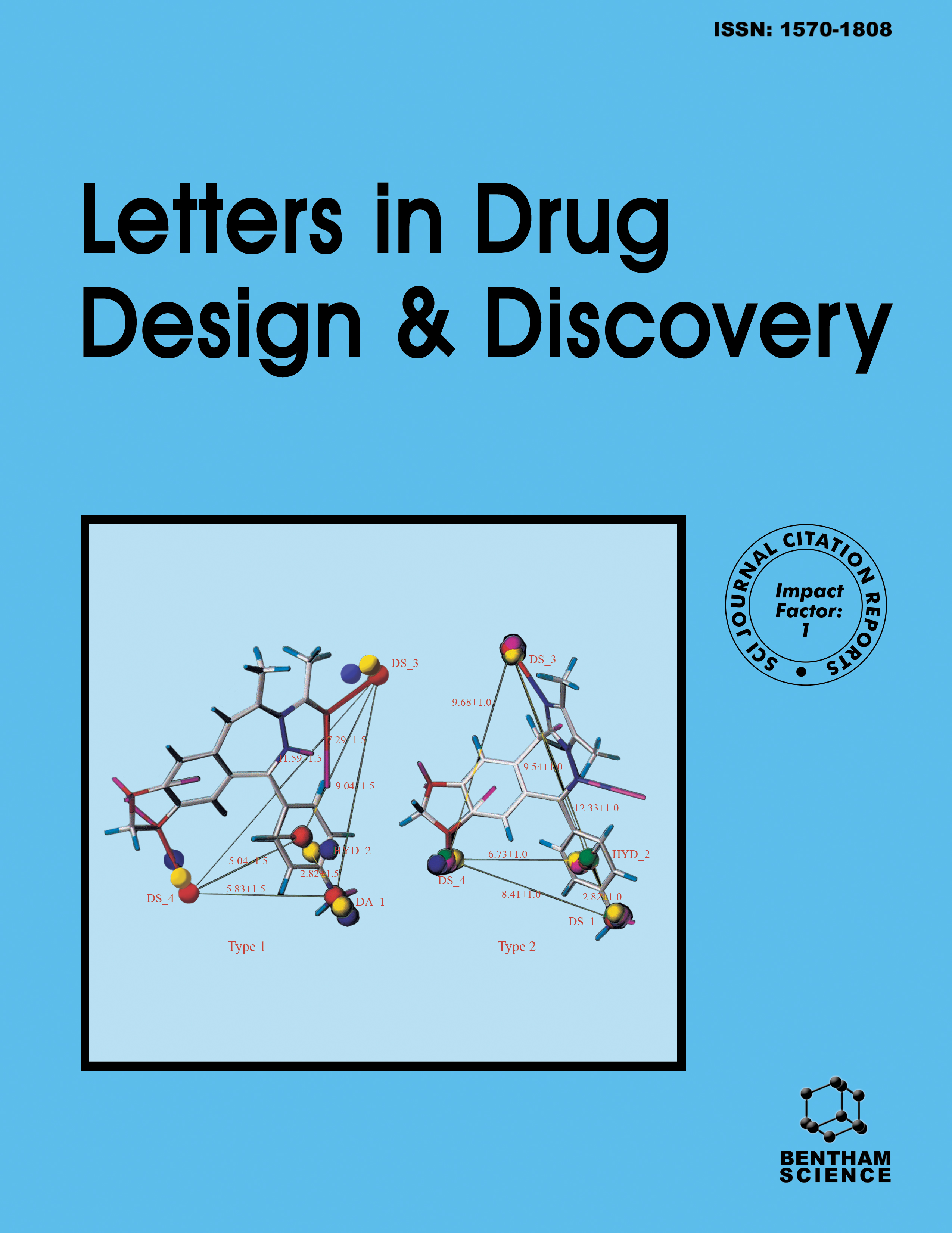- Home
- A-Z Publications
- Letters in Drug Design & Discovery
- Previous Issues
- Volume 20, Issue 3, 2023
Letters in Drug Design & Discovery - Volume 20, Issue 3, 2023
Volume 20, Issue 3, 2023
-
-
A State-of-the-art Review on Keratin Biomaterial as Eminent Nanocarriers for Drug Delivery Applications
More LessAuthors: Venkataramanan Srinivasan and Ponnusamy PalanisamyThe utilization of biomaterials in the human body was first practiced several years ago to restore normal functional activities by replacing the impaired organs with bio-inspired materials without devastating the cells and tissues. Today, many advanced technologies are reported to be worthwhile to effectively prepare different categories of biomaterials with amplified properties and characteristics for therapeutic applic Read More
-
-
-
A Brief Study on Drug Repurposing: New Way of Boosting Drug Discovery
More LessAuthors: Kamal K. Kaushik, Rupa Mazumder, Abhijit Debnath and Manisha PatelBackground: Even with the massive increase in financial investments in pharmaceutical research over the last decade, the number of new drugs approved has plummeted. As a result, finding new uses for approved pharmaceuticals has become a prominent alternative approach for the pharmaceutical industry. Objective: Drug repurposing or repositioning is a game-changing development in the field of drug research tha Read More
-
-
-
A Study of Ungernia trisphaera Bunge and Thymus transcaspicus Cytotoxicity in Cancer Cell Lines
More LessObjective: Thymus transcaspicus (Lamiaceae) is an Iranian species of Thymus, and Ungernia trisphaera Bunge belongs to the family Amaryllidaceae. Cytotoxic properties of total ethanolic extract of T. transcaspicus and U. trisphaera were investigated against different cell lines including B16F10, PC3, U87, and MCF-7. Methods: The proliferation, cell cycle, and migration of the cells were determined by thiazolyl bl Read More
-
-
-
Design and Screening of KLHL22 Inhibitors by Homology Modeling, Molecular Docking, and Molecular Dynamics Simulation
More LessAuthors: Chenglong Gao, Chuance Sun, Lichuan Zhang, Haoran Zhang, Rilei Yu and Congmin KangBackground: Kelch-like protein 22 (KLHL22) was a newly discovered proto-oncogene and it is highly expressed in multiple breast cancer cell lines. Inhibition of KLHL22 can induce autophagy in tumor cells by regulating the mTORC1 pathway. Methods: In this study, the structure of the KLHL22 protein was predicted by homology modelling. The model was evaluated by Ramachandran Plot and Profile-3D. Virtual screening of a dr Read More
-
-
-
Aminoquinoline-triazine Conjugates: Design, Synthesis, Antibacterial Activity, and SAR Analysis
More LessAim: Frequent use of antibiotics is responsible for the development of antibiotic resistance; thus, there is an urgent need for the development of new antibacterial agents that act by novel mechanism pathways. Objective: The aim of the study was to develop hybrid novel 4-aminoquinoline 1,3 5-triazine derivatives and determine their antibacterial activity. Methods: Novel hybrid 4-aminoquinoline 1,3,5-triazine derivatives were s Read More
-
-
-
Fragment-Based Drug Design, 2D-QSAR and DFT Calculation: Scaffolds of 1, 2, 4, triazolo [1, 5-a] pyrimidin-7-amines as Potential Inhibitors of Plasmodium falciparum Dihydroorotate Dehydrogenase
More LessBackground: Plasmodium falciparum dihydroorotate dehydrogenase (PfDODH) is one of the enzymes currently explored in the treatment of malaria. Although there is currently no clinically approved drug targeting PfDODH, many of the compounds in clinical trials have [1, 2, 4,] triazolo [1, 5-a] pyrimidin- 7-amine backbone structure. Objective: This study sought to design new compounds from the fragments of known ex Read More
-
-
-
Design, Synthesis, and Anti-Bacterial Evaluation of Tetrahydrobenzothiophene Derivatives as Lipopolysaccharide Biogenesis Inhibitors
More LessAuthors: Shuchen Pei, Jinhua Yang, Shihao Xia, Shuting Tang, Kangyao Yuan and Jun ChenBackground: Bacterial infections caused by multidrug-resistant bacteria have emerged as major threats to human communities worldwide. There is a great need to develop new mechanisms by which anti-bacterial agents can combat bacterial antibiotic resistance. Objective: This study aims to synthesize and characterize a series of novel tetrahydrobenzothiophene derivatives and evaluate their anti-bacterial activities. Methods: Read More
-
-
-
Design and Optimization of Sustained-Release Trihexyphenidyl Hydrochloride Nanoparticles: Design of the Experiment Approach
More LessAuthors: Ajaygiri K. Goswami, Premraj Ramesh Patil and Nitin Rajendra ShirsathBackground: Trihexyphenidyl chloride (THP) is an antidyskinetic medication used in single and combination therapy to symptomatically treat Parkinson's disease. Due to its fast metabolism and short elimination of half-life, it causes changes in plasma concentrations and requires frequent dosage. Objective: The aim of this study was to prepare a sustained release formulation of Trihexyphenidyl chloride (THP). Materials and Read More
-
-
-
Bioactive Compounds from Mimosa pudica Leaves Extract with Their α- glucosidase and Protein Tyrosine Phosphatase 1B Inhibitory Activities in vitro and in silico Approaches
More LessBackground: Mimosa pudica Linn has been used in traditional medicine to support the treatment of type 2 diabetes. In the present study, we aimed to isolate and evaluate α-glucosidase and Protein Tyrosine Phosphatase 1B (PTP1B) inhibitory activities of bioactive compounds from Mimosa pudica’s leaf extract. Methods: Mimosa pudica leaves were extracted with 80% of ethanol. Bioactive compounds were isolated using a c Read More
-
-
-
Optimized Synthesis and Cytotoxic Activity of α-Aminophosphonates Against a Multidrug Resistant Uterine Sarcoma Cell Line
More LessAuthors: Petra R. Varga, Dinny, SzilT SNM, Gergely Szak and Gy KeglevichBackground: α-Aminophosphonates are potentially biologically active species. Objective: We wished to compare the synthetic methods and evaluate the effect of the α- aminophosphonates on sarcoma cell lines. Methods: We investigated microwave-assisted Kabachnik–Fields and Pudovik reactions, as well as substitutions, and applied in vitro cytotoxicity screening. Results: The Kabachnik–Fields condensation and th Read More
-
Volumes & issues
-
Volume 21 (2024)
-
Volume 20 (2023)
-
Volume 19 (2022)
-
Volume 18 (2021)
-
Volume 17 (2020)
-
Volume 16 (2019)
-
Volume 15 (2018)
-
Volume 14 (2017)
-
Volume 13 (2016)
-
Volume 12 (2015)
-
Volume 11 (2014)
-
Volume 10 (2013)
-
Volume 9 (2012)
-
Volume 8 (2011)
-
Volume 7 (2010)
-
Volume 6 (2009)
-
Volume 5 (2008)
-
Volume 4 (2007)
-
Volume 3 (2006)
-
Volume 2 (2005)
-
Volume 1 (2004)
Most Read This Month
Article
content/journals/lddd
Journal
10
5
false
en


